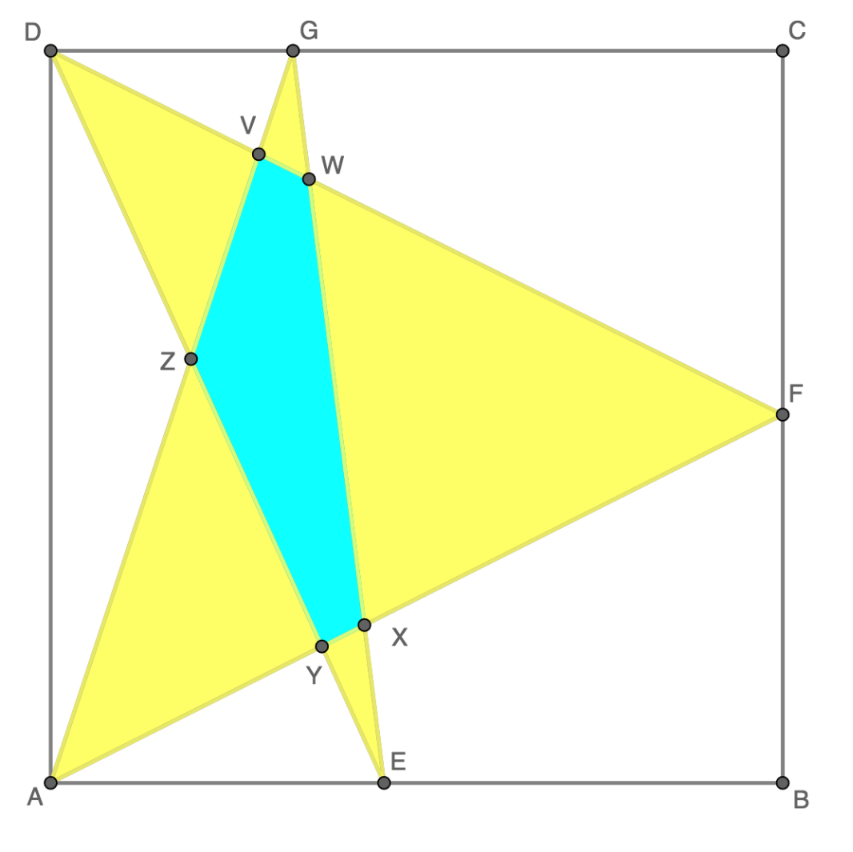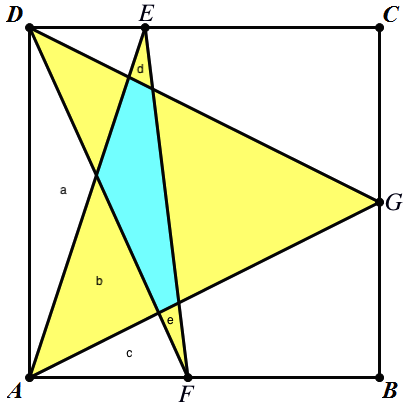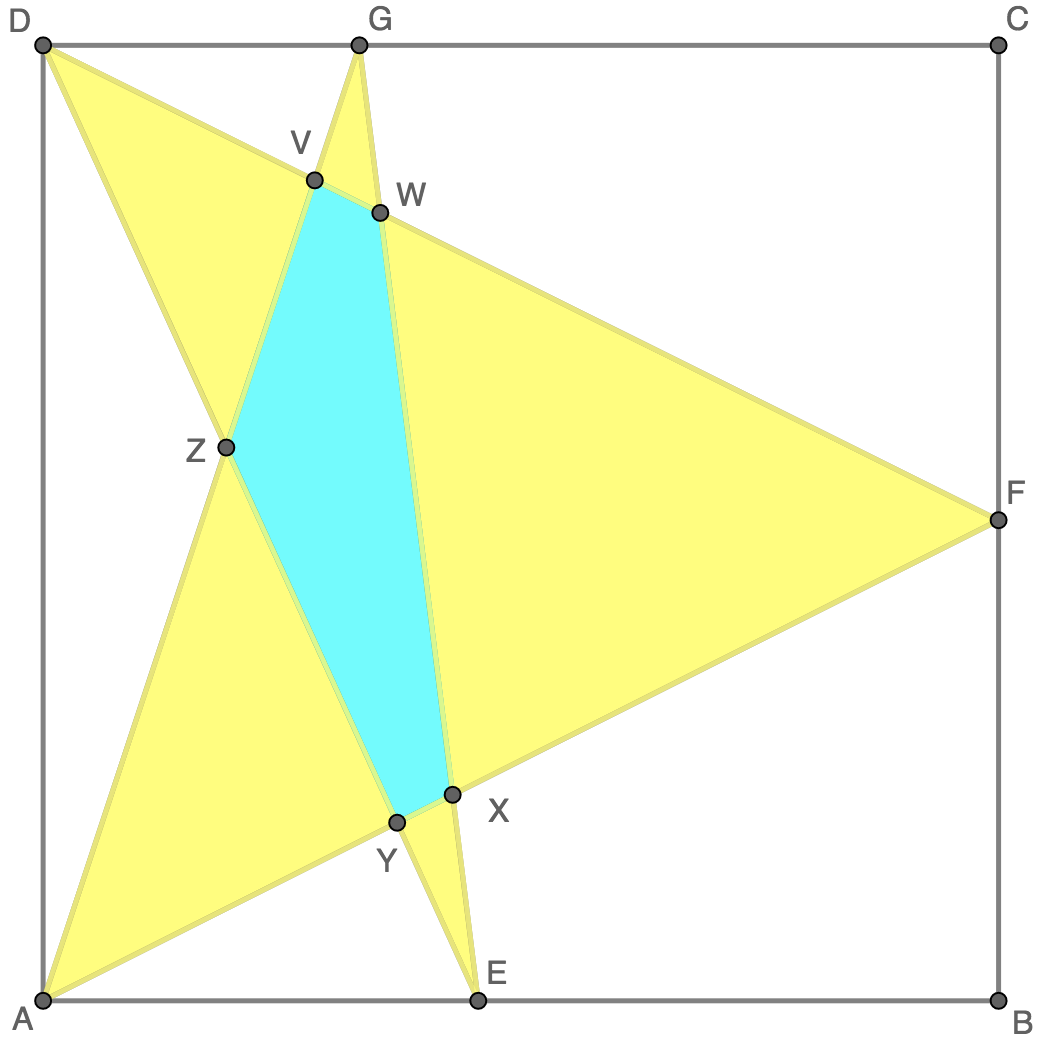A star in a square
The square has side length 1 2 , and the area of the blue region is 1 2 .
What is combined area of the yellow regions?
The answer is 48.0.
This section requires Javascript.
You are seeing this because something didn't load right. We suggest you, (a) try
refreshing the page, (b) enabling javascript if it is disabled on your browser and,
finally, (c)
loading the
non-javascript version of this page
. We're sorry about the hassle.
6 solutions
Very nice I was thinking about a inteligent solution like this but didn't thought about this combination so finally I opted for a more traditional one.
In this picture, let AE and DF intersect at X. Obviously, the area of ADE is equal to that of FDE, so if we subtract the public area we will find the area of ADX is equal to that of EFX. The area of ADG is 72, which is equal to the area of EFX plus that of AXDG, which is the area of yellow and 2 of the area of blue. As we know that blue area is 12, we can solve the yellow area.

The area of the square is 144. If the yellow were a full triange (ΔAFD) then its area would be exactly half that (= 72).
Now, assume EG is vertical, so we can calculate for the symmetric case where ΔEZG is flipped into ΔAZD. The complete triangle ΔAFD (area 72) now has two chunks of blue cut out of it. So subtract 12 twice. Answer: 72 - (2 * 12) == 48
(I took a shortcut to assume symmetry here, without proof, because if asymmetry changed the answer then the problem wouldn't have a solution ... Edit: Thanks Pascal Engeler for the proof [in reply-comment])
Here's the proof you need for your Solution:
The Triangles AED and AEG have the same area size, because you can calculate them the same way: AE*AD/2 (AD is in both cases the height of the triangle). Then you can subtract the smaller Triangle AZE from both Triangles. This concludes that ΔAZD and ΔEZG are the same Size.
Log in to reply
This is such an elegant solution!!
I don’t understand this, does the proof not assume that AE is equal to DG? AZD triangle is equal to AE AD/2, and the EZG triangle would equal AD DG/2, but DG doesn’t look like it’s equal to AD? Thanks.
Log in to reply
- ADE is AYE + AZY + AZD
- AGE is AYE + AZY + EZG
Log in to reply
@Dave Whipp – Only if you assume that ADE=AGE, which you can't proof because the height (AD) is the same, but the bases (AE & DG) are unknown and EG doesn't seem purpendicular to AE. Based on what info do you assume AE=DG?
Log in to reply
@Tim Geijtenbeek – Both triangles have the same base, AE. The line DG isn't part of any of the triangles of interest. Any triangle with base AE, with third vertex anywhere on DG (or on DC) will have the same area.
This is a great solution, but if triangles EZG = AZD then the area of AZD > 12 because 2 parts of triangle EZG are yellow and the remaining blue part is 12. This means the answer is a little bit bigger than 48 rather than spot on. Am I reading the problem statement correctly?
Log in to reply
See Pascal's proof: ΔAZD and ΔEZG have exactly the same area, because ΔAZE is shared between both ΔAED and ΔAEG.
Its ok not to assume EG to be perpendicular because ZDA and ZGE will have same area because the triangles DAE and GAE will have same areas as they lie between same parallels and have same height and we can get ZDA and ZGE have equal area by subtracting the area ZAE from both the triangles
 First, thanks to Joseph Newton for the picture. After some dead-ends, I noted that triangles ADF and AEF have the same areas, as they share a base length and height. I've labelled the regions inside these triangles a through e.
First, thanks to Joseph Newton for the picture. After some dead-ends, I noted that triangles ADF and AEF have the same areas, as they share a base length and height. I've labelled the regions inside these triangles a through e.
The area of ADF is then a + b + c, and AEF is 12 + b +c + d + e.
Setting these equal, b and c cancel leaving a = 12 + d + e
The triangle ADG is half the square's area: 72, and to get the yellow area, a and 12 must be subtracted, and d and e added:
Yellow Area = 72 - (12 + d + e) - 12 + d + e = 72 - 12 -12 = 4 8
Really nice. This problem stumped me!
I think your solution is the most straight forward.
But AF(base of AEF) > DE (base of ADF), right? And the height (AD) is the same. So how can AEF=ADF?
Log in to reply
Base of ADF can be AF because any of the three sides of a triangle can be taken as base.
Clearly line EF is not vertical, which is assumed by these solutions. What gives?
Log in to reply
This solution doesn't require EF to be vertical
EF need not be vertical, because the area of a triangle is 1/2 x base x height. All triangles with their base along AF and their third vertex touching the top edge of the square will have the same area.

Label the points as shown above. Let [ A 1 A 2 ⋯ A n ] denote the area of the polygon with vertices A 1 , A 2 , ⋯ , A n . From the problem statement, we are given that [ V W X Y Z ] = 1 2 and [ A B C D ] = 1 2 2 = 1 4 4 . Note that the area of △ A D F is half of square A B C D , so [ A D F ] = 2 1 ( 1 2 2 ) = 7 2 .
Let a = D Z , b = G Z . Since △ A E Z ∼ △ G Z D , we have E Z = r D Z = r a and A Z = r G Z = r b for some positive real number r . We can use these side lengths to find [ A Z D ] and [ E Z G ] :
[ A Z D ] = 2 ( A Z ) ( D Z ) sin ∠ A Z D = 2 r a b sin ∠ A Z D [ E Z G ] = 2 ( E Z ) ( G Z ) sin ∠ E Z G = 2 r a b sin ∠ E Z G .
Since ∠ A Z D = ∠ E Z G , we conclude that [ A Z D ] = [ E Z G ] .
Let K = [ Z A Y ] + [ Y E X ] + [ X F W ] + [ W G V ] + [ V D Z ] i.e. the area of the yellow region. Note that
[ A Z D F ] + [ E Z G ] = ( [ Z A Y ] + [ X F W ] + [ Y E X ] + [ V D Z ] + [ V W X Y Z ] ) + ( [ Y E X ] + [ W G V ] + [ V W X Y Z ] ) = K + 2 ( 1 2 ) = K + 2 4 .
However, because [ E Z G ] = [ A Z D ] , we also have
[ A Z D F ] + [ E Z G ] = [ A Z D F ] + [ A Z D ] = [ A D F ] = 7 2 .
Thus, K + 2 4 = 7 2 , or K = 4 8 , and we are done.
Since [AZD] = [EZG], we have: 12x12:2 = 72 = [AFD] = [AFDZ]+[EZG] = Yellow regions + 2 Blue region.= Yellow regions + 2x12 Hence: Yallow regions = 72 - 2x12 =48. Ans: 48
If you moved the smallest yellow triangles into the corresponding areas of the large white triangle, the resulting shape is the same as the blue pentagon so has an area of 12. (I had a diagram but it wouldn't let me insert it, sorry).
So because the yellow area plus the blue and the white version that we made in the last sentence, makes up half of the square, so overall 72.
Then minus the two lots of 12 from 72 and you get 48.
Well this is my attempt and I am not 100% sure about the first point but here it goes:
First, lets name the left vertex of the blue area H It can be observed that the area of D A H is equal to the area of E H F . So let's shift E H F into D A H
What we end up with is a triangle D A G with a missing area in the middle which has the size of 12 (used to be the blue area). We also need to subtract the blue shifted area. So the yellow area will be the area of D A G − 2 ( 1 2 ) Because of [ D A G ] = ( 1 2 ∗ 1 2 ) / 2 we end up with ( 1 2 ∗ 1 2 ) / 2 − 2 ∗ 1 2 = 4 ∗ 1 2 = 4 8
Let's add up the triangles ADF, ADE, DCG, ABG and the trapezium ECBF. This will count all the yellow areas once , as each yellow segment appears in one of the shapes listed, and it will also count all the white areas twice , as each white segment appears in two of the shapes listed. So: Y + 2 W = [ A D F ] + [ A D E ] + [ D C G ] + [ A B G ] + [ E C B F ] = 2 1 ( 1 2 ) A F + 2 1 ( 1 2 ) D E + 2 1 ( 1 2 ) C G + 2 1 ( 1 2 ) G B + 2 1 2 ( E C + F B ) = 6 ( A F + D E + C G + G B + E C + F B ) But A F + F B = 1 2 , D E + E C = 1 2 and C G + G B = 1 2 , so Y + 2 W Y + W + W B + Y + W + W = 6 ( 1 2 + 1 2 + 1 2 ) = 2 1 6 = 2 1 6 + 1 2 = 2 2 8 Now, B + Y + W must equal 1 2 2 , as all the areas added together make up the whole square. 1 4 4 + W W = 2 2 8 = 8 4 Now we can determine the size of the yellow area: Y + W + B Y + 8 4 + 1 2 Y = 1 4 4 = 1 4 4 = 4 8 So the answer is 4 8